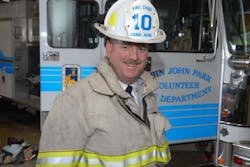Chief Jim Seavey, Sr. is a 42-year veteran of the fire service, currently serving as the chair of the Cancer Committee for the Volunteer & Combination Officers Section of the IAFC, co-chair of the Cancer Sub-committee for the National Volunteer Fire Council (NVFC) as well as the fire chief for the Cabin John Park, MD, Volunteer Fire Department.
How Did You Learn that You Had Cancer?
I had been noticing that I had been sleeping a lot more. I went from a 35-year career, including my volunteer time, of sleeping 3–4 hours as my normal amount of sleep to sleeping at least 12 hours a day almost overnight. I had a full physical. Blood work, everything came back normal. I was fine. I went another month, my lymph glands started popping on my neck, both front and rear, so I went for a biopsy.
Five days later, my wife called me and said, “Call the doctor, he wants to talk to you about your biopsy.” I called him and he said, “I hate to tell you this, but you have malignant lymphoma. You have low-grade Stage 3 non-Hodgkins.” That changed my life forever, and you can’t take it back.
When your body changes dramatically, in any regard—hunger, weight, sleep—something is wrong, and it’s telling you something and you’ve got to go get it checked out. Don’t stop with the traditional physical. There were a couple tests that weren’t in the blood work tests that would have revealed it, but they weren’t part of a standard physical.
How Has the Fire Environment Changed Since You Started Fighting Fires?
I started in 1976 and I was taught that we could easily go into a fire and get it knocked down without having to worry about a mask, and of course at that time, masks/SCBA were limited. Now when I go into a fire, you immediately recognize the irritation to both your nose and throat, and it’s beyond the kind of irritation you would get with a real deep inhalation of paper and wood smoke. This is very carcinogenic off-gassing and toxic gases, including the CO of the smoke, so it’s certainly now suicide to not don your SCBA.
What Is Your Message to Younger Firefighters?
You have to protect yourself. As a safety officer, I routinely saw people who sent their same set of gear out for cleaning when we provide you the opportunity to clean both. We have primary and secondary sets, as we do in my volunteer department. And we have two cleanings per year for the sheer fact of cleaning one set, then the other. I noticed there was a propensity with many of the firefighters to send one set out all the time, so they could keep the “salty” set. And they also knew that if they had 10 years, it was not coming back; it would be condemned. And at 10 years, you have really broken in a coat—that’s a comfortable set of PPE, and you hate giving it up to break in a brand new set. But the bottom line is we’re trying to save your life. And the quicker you learn that, the better off you’ll be. I think people like myself need to go around this country and tell our story and impress upon the new firefighters, the younger generation, that it’s very, very easy to prevent this if you use everything you are provided.






